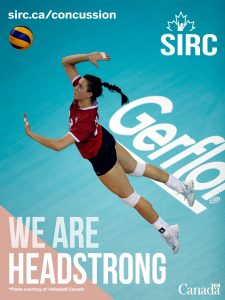It might be surprising to hear concussions are a serious risk in the sport of volleyball. But data collection from Volleyball Canada—dating back to 2016—has revealed exactly that.
“Our research has shown that about 1 in 10 youth athletes in Canada will sustain a concussion while playing club volleyball each year.” said Kerry MacDonald, Director, Sports Science, Medicine & Innovation, Volleyball Canada, referring to research done in partnership with the University of Calgary.
These numbers re-enforce what many in the volleyball community already knew: that concussions are part of the sport. But for those wondering how concussions happen in a sport with two teams separated by a net, Dr. MacDonald’s research also looked at causes. “Ball contact to the head is our primary mechanism of concussion,” said MacDonald, adding that falls to the floor are another contributor, “just not the primary cause.”

As a result of the findings, changes have been happening within the sport in Canada – big and small. Volleyball Canada has updated its concussion protocol, aligned with the Canadian Guideline on Concussions in Sport. The national body is also making specific policy changes to drills and training techniques. One example involves a common warm-up drill: a player attacks the ball over the net, then they would immediately go duck under the net to retrieve their ball.
“As they were doing that, their teammates were following behind them and doing the same thing, and basically hitting balls at them as they run through their court. So, we’ve made a policy change whereby athletes can no longer go under the net into that dangerous, high-risk area,” said Dr. MacDonald, adding that this specific change is being implemented this coming club season.
MacDonald’s team is also looking at equipment, paying close attention to emerging research on the different types of balls. “Preliminary data shows significant differences in the mechanical properties of various types/brands of balls. What we’re trying to understand is how certain properties could influence the risk of concussion, and that will hopefully drive decisions down the road in terms of which types we’re using for youth volleyball in Canada.”
Amid these progressive changes being made at Volleyball Canada, one of the biggest challenges remains the dissemination of information – educating athletes, parents, coaches and officials around the risks in volleyball.
“Considering and learning about the value of harmonized approach and adopting that into our protocol has been critical,” said MacDonald. “Providing guidance based on evidence and best practices is something SIRC has really led on, and been incredibly helpful and beneficial for us as a NSO.”
Informed by data, volleyball’s decision-makers have been empowered to make important change. Proper education requires time, but the sport is doing everything in its power to create a safe environment.
This blog is part of SIRC’s #HeadstrongCanada concussion awareness, prevention and management campaign. The campaign features tools, resources, and best practices in managing and preventing concussions in sport in Canada. Developed in partnership with Sport Canada, Public Health Agency of Canada and other organizations, the toolkit offers credible information and templates recognized by stakeholders throughout the sport system.
Check out the concussion website for concussion information and tools to help your sport be concussion smart. For concussion information directly to your inbox, sign up for SIRC’s concussion newsletter.